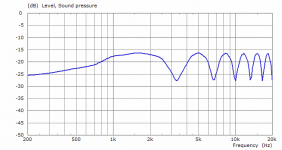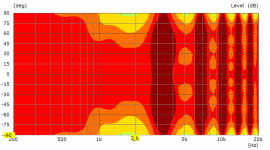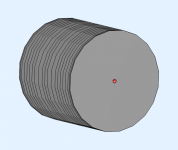This is not as easy to do as it sounds. The absorption would need to be quite expansive to completely null the diffraction at a baffle edge.You can of course *effectively* eliminate the effects of baffle diffraction through absorption.
I don't quite follow this, but the suggestion that a dipole baffle does not diffract sound is wrong.Also, as others have already suggested: making it maximally diffractive at a freq. sufficiently above it's passband (with an appropriately steep crossover) is also effective. (..basically the "no-baffle" approach eventually adopted by JohnK and SL.)
As a study, it might be interesting to determine:
1. at what freq.s diffraction effects are deemed increasingly negative to a listener, and
2. at what amplitudes relative to the average are diffraction effects deemed increasingly negative to a listener, and
3. (in relation to pressure-loss), which is deemed more negative: either broad passband diffraction effects or narrow passband diffraction effects.
Lidia and I did a simple study (large # subjects in a blind lab setting) of what was intended to be diffraction. The results were two parts quite expected and one part very interesting. The higher the level of diffraction and the longer the time delay the more audible it is (expected). The interesting part was that as the absolute SPL went up the diffraction became more audible. Diffraction is a linear effect, like a resonance. But a resonance will not change it audibility with level. Normally we think of nonlinear distortion as having this effect, which means that diffraction acts much like nonlinear distortion, becoming more audible as the level goes up.
The takeaway here is that many could interpret diffraction as nonlinear distortion and that diffraction is always going to audible at some SPL level.
...
The takeaway here is that many could interpret diffraction as nonlinear distortion and that diffraction is always going to audible at some SPL level. ...
Yes. Diffraction may cause a most disturbing distortion of the stereo illusion.
In my hypothesis we are most sensitive to everything that's happening within a time lapse corresponding to the interaural time difference. Because every secondary impulse within this time-gap by itself may evoke psychoacoustically a potential spacial (horizontal) information along with the initial impulse. Which blurs the stereo image - and which potentially has an alarming content, also (we grew up in the savannah, and back there it was important to hear from which direction a hungry predator came lurking, even in a relaxed and closed-eyed state - relaxed like today listening to our stereo).
This is why I think it is most important to avoid as much as diffraction within the first 1ms, say some 12". Otherwhise, as said before, stereo spaciousness and listening enjoyment will suffer. I assume that boundry diffraction effects on larger baffles (>12") may have at least no more the alarming component, because there is no more the psychoacoustic correlation of space discrimination.
Last edited:
I realise the OP is asking about baffle design but shouldn't we also consider the driver itself and how it radiates? The problem seems to mainly occur with convex dome tweeters, horns have been touched on briefly but how about inverted dome, cone or wideband, wouldn't they be preferable?
Yes. Diffraction may cause a most disturbing distortion of the stereo illusion.
In my hypothesis we are most sensitive to everything that's happening within a time lapse corresponding to the interaural time difference. Because every secondary impulse within this time-gap by itself may evoke psychoacoustically a potential spacial (horizontal) information along with the initial impulse. Which blurs the stereo image - and which potentially has an alarming content, also (we grew up in the savannah, and back there it was important to hear from which direction a hungry predator came lurking, even in a relaxed and closed-eyed state - relaxed like today listening to our stereo).
This is why I think it is most important to avoid as much as diffraction within the first 1ms, say some 12". Otherwhise, as said before, stereo spaciousness and listening enjoyment will suffer. I assume that boundry diffraction effects on larger baffles (>12") may have at least no more the alarming component, because there is no more the psychoacoustic correlation of space discrimination.
I might extend the time gap by a few ms., but I generally agree. I have found that even removing diffraction from objects near the speakers can improve the stereo image (assuming, of course that the speakers them selves have minimized their diffraction.)
I realise the OP is asking about baffle design but shouldn't we also consider the driver itself and how it radiates? The problem seems to mainly occur with convex dome tweeters, horns have been touched on briefly but how about inverted dome, cone or wideband, wouldn't they be preferable?
Preferable in what sense?
Of the sources that you mention only the horn (waveguide) can be constant directivity, so yes, the sources radiation is indeed important and internal diffraction from these sources is also an issue. Minimizing all diffraction is the challenge, while maintaining a constant directivity. Not easily done.
If on wall mountng greatly reduces diffraction and also eliminates the baffle step issue for bass dispersion WHY do we have speakers pulled out away from the wall in the first place ????
It depends on what kind of speakers. For example, my speakers for a HT are in walls, and a sub under the floor. They are multi-way, and connected to corresponding amplifiers, crossed over and EQed by DSP. But when I test my amps, I use simple 3-way speakers standing on a floor. Also, I have 6 foldable sections of line arrays, for venues in clubs and on open spaces.
There is a difference between stationary and portable speakers. However, concrete boxes can be portable as well, but what's the point?
In that they have narrower dispersion than a dome and thus the baffle edge has less effectPreferable in what sense?
They all have a narrowing directivity with frequency except the horn. But directivity in the far field is not the same as the near field. Even though the directivity is narrow the source will still radiate into a baffle edge. Somewhat less, to be sure, but its still there.
Diffraction is not always bad. Most of the free-standing speakers benefit from the narrowing in directivity from baffle diffraction. The secondary wave adds constructive to the direct sound under 0° which is equivalent to a narrowing of directivity. Only above the real problems begin.
Example (cylinder: r = 100 mm, source: r = 4 mm):
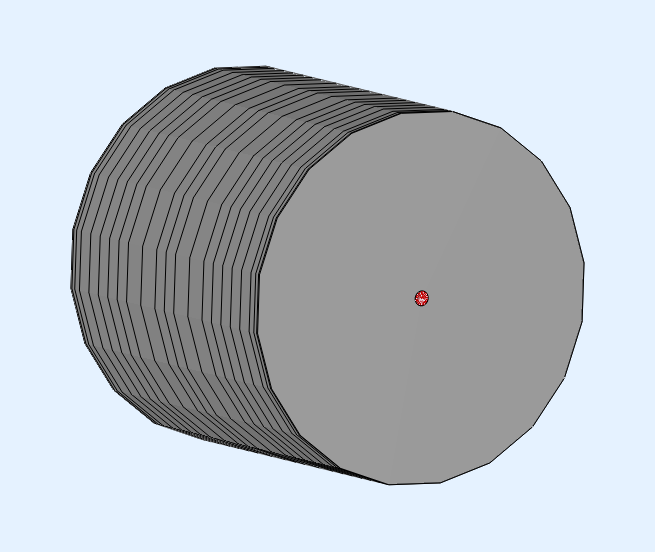
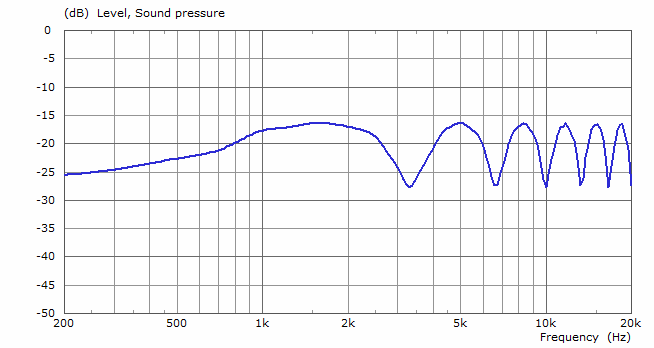
Normalized directivity:
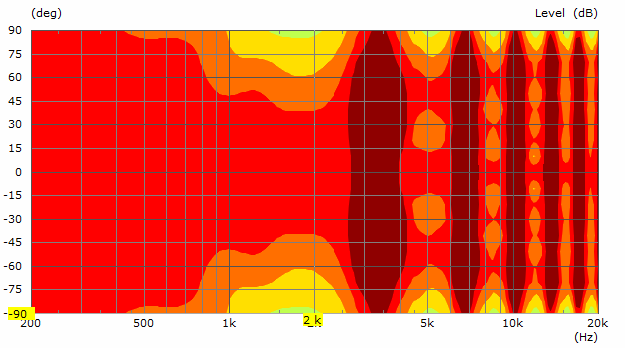
In this example the range between about 800 Hz and 2,2 kHz is narrowed by diffraction and can be used to shape the directivity. Of course on rectangle shaped baffles the diffractions fall to different frequencies which "smears" the effect. I used a circular shape in this example, because it makes it easier to understand.
Btw. it is more effective to use a beaming source than to round the edges. E.g. a horn/waveguide or a bigger driver don't "see" the edges wheras rounding is always limited to its radius.
Example (cylinder: r = 100 mm, source: r = 4 mm):
Normalized directivity:
In this example the range between about 800 Hz and 2,2 kHz is narrowed by diffraction and can be used to shape the directivity. Of course on rectangle shaped baffles the diffractions fall to different frequencies which "smears" the effect. I used a circular shape in this example, because it makes it easier to understand.
Btw. it is more effective to use a beaming source than to round the edges. E.g. a horn/waveguide or a bigger driver don't "see" the edges wheras rounding is always limited to its radius.
Attachments
Very good point Nils. Those simulations demonstrate it very clearly. I used this phenomenon as I explained in this post: http://www.diyaudio.com/forums/mult...design-improve-diffraction-8.html#post5171811
I hardly call that an example of the designer controlling directivity through diffraction. It's a mess. Period.
You didn't get the point. Sometimes it is better to show an effect using an ideal (and not practical) example than with a real one. Of course no one would build such a cylinder with an 8 mm tweeter on it.
The point is that nearly all speakers (which are not in-wall) use this narrowing effect for directivity. Putting a speaker in a wall eliminates this. Please take a look at my document. At page 22 ("Freistehendes Horn") there is a simulated horn in infinite baffle and a free-flying enclosure with the baffle dimensions of the horn. Both effects superpose which is shown by the real horn (3D printed).
Diffraction and baffle step compensation/minimization implies a multi-way construction. A single issue usually happens and can be eliminated in 1-2 octaves only. usually things get difficult in upper range of passband.
My multiway-dipoles (clic signature) can't avoid edge diffractions around and 6-8kHz. (Bumps around 600-800Hz are due environment)
ainogneo83 vx out dir 0-180 treb rta.jpg - Google Drive
ainogneo83 vx out polargraphs.jpg - Google Drive
My multiway-dipoles (clic signature) can't avoid edge diffractions around and 6-8kHz. (Bumps around 600-800Hz are due environment)
ainogneo83 vx out dir 0-180 treb rta.jpg - Google Drive
ainogneo83 vx out polargraphs.jpg - Google Drive
You didn't get the point. Sometimes it is better to show an effect using an ideal (and not practical) example than with a real one. Of course no one would build such a cylinder with an 8 mm tweeter on it.
The point is that nearly all speakers (which are not in-wall) use this narrowing effect for directivity. Putting a speaker in a wall eliminates this. Please take a look at my document. At page 22 ("Freistehendes Horn") there is a simulated horn in infinite baffle and a free-flying enclosure with the baffle dimensions of the horn. Both effects superpose which is shown by the real horn (3D printed).
I think that one has to talk about the delay of the diffraction and whether or not it is within a period or two of the signal or not. All diffraction greater than this will be detrimental as they will be detected as separate events. If they are under this time then they only affect the directivity.
For example the whole directivity of a circular piston is due to the diffraction at the edge. This can be shown by placing a point source on a baffle and then a ring of sources at some distance with an amplitude and phase equivalent of the diffraction that the point source would have at that distance from a baffle discontinuity. What one will get is the exact same polar response as that of a rigid disk of the same diameter as the diffraction ring. So all directivity is a result of diffraction, but in the ideal case of the above diffraction example it is very close in time with the direct wave and won't be heard as a separate event.
@gedlee
I absolutely agree with you. The first hump (in my example at 1 - 2 kHz) is generated within the first period of the wave. To be more specific: the reflection comes with the second half-wave. The reason is that the edge is a loose end thus the reflected wave is inverted. The first hump always occur when wavelentgth / 2 equals the distance between source and edge.
All higher order reflections are outside the first period and this is what I meant with "Only above the real problems begin". But these can be treated with a waveguide.
I absolutely agree with you. The first hump (in my example at 1 - 2 kHz) is generated within the first period of the wave. To be more specific: the reflection comes with the second half-wave. The reason is that the edge is a loose end thus the reflected wave is inverted. The first hump always occur when wavelentgth / 2 equals the distance between source and edge.
All higher order reflections are outside the first period and this is what I meant with "Only above the real problems begin". But these can be treated with a waveguide.
All higher order reflections are outside the first period and this is what I meant with "Only above the real problems begin". But these can be treated with a waveguide.
Exactly! In the 8c I fixed it with both a waveguide an a large radius on the baffle edge. There are hardly any diffraction effects left when you look at the ETC, directivity and frequency response plots.
Dr. Geddes, it's good to see you still post here. I really should thank you for putting me on the path of waveguides and dealing with edge diffraction, years ago. You were absolutely right!
I really should thank you for putting me on the path of waveguides and dealing with edge diffraction, years ago. You were absolutely right!
Thanks, I have been doing this for almost 20 years now.
The next big benefit that I have found is attention to diffraction in the room nearby the speakers. I always see photos of peoples setup with lots and lots of stuff all around the speakers diffracting away. My setup is very clean with virtually nothing to diffraction for several feet. The nearest items are the other speakers, where rounded edges also help this secondary diffractio0n.
- Home
- Loudspeakers
- Multi-Way
- What are some good example of baffle design to improve diffraction
